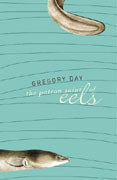 | Reviews of The Patron Saint of Eels by Gregory Day. |
Description: "A contemporary fable, this book shows that when life seems dull and cruel it is the power of the natural world, and our ability to imagine it, that can bring the wonder back into living.
"In the southern Italian village of Stellanuova, in the 1700s, a Franciscan monk, Fra Ionio, becomes known as the Patron Saint of Eels when he brings a distraught fisherman's yearly catch of eels back from the dead in the village market. When Stellanuova's inhabitants emigrate to Australia in the post World War II migrations of the 1940s, 50s and 60s, the immortal saint is left looking down on an abandoned town. To fulfil his calling, he decides in heaven to migrate with his countrymen and now looks down on the state of Victoria, where he intercedes in matters relating to eels.
"In the southern Victorian town of Mangowak, Noel Lea lives with the melancholy inheritance of a place undergoing the gentrifications of contemporary Australia. Along with his oldest friend, Nanette Burns, he longs for a time when life was less complex and unexpected magic seemed to permeate the ocean town and its people. When spring rains flood a nearby swamp and hundreds of eels get trapped in the grassy ditches around Noel's family home, he and Nanette encounter the vibrant Fra Ionio and get more magic than they bargained for."
In "Australian Book Review", Sarah Kanowski finds a lot to like with the novel but then determines that the author's approach may be a limiting factor: "Gregory Day depicts a country world of pub yarns, simple happiness and a deep, if unarticulated, connecton to the land. Its heroes are old bush characters still in possession of 'that vast and intimate family knowledge born out of the gifts of improvisation and bushcraft, of getting by.' The rendering of everyday speech is not easy, and Day handles its blunt cadences well. However, a perception of the world that is dominated by telling silences necessarily falters when called on to articulate the miraculous".
On the other hand, Lisa Gorton in "The Age" doesn't have the same problems: "Day is a musician as well as a writer and The Patron Saint of Eels is composed like music, with a pattern of recurring phrases and images that carry his theme in different keys. In this way, it is a highly deliberate work, with its depths all brought to the surface, as it were. If this extreme clarity is to some extent the novel's limitation, it is also part of its charm. For it is the self-consistency of Day's style and theme that allows him to bring together so many quirky and various things: comical accounts of local characters and pious reflections on the meaning of landscape; Mangowak history and the story of how a Franciscan monk in the southern Italian village of Stellanuova became the Patron Saint of Eels."
In the Australian, Liam Davison is quite impressed with the work: "In [this] wonderful first novel, the enigma of the eel becomes the central metaphor for the charming contemporary fable about migration and belonging, and mortality and belief." Which, on the face of it, seems to stretch the bonds of credibility somewhat. But Davison is a major novelist himself so he knows where a reader might be a little dubious: "In another writer's hands, this quasi-religious fable with its veiled social and environmental agenda might have tested the credulity and goodwill of its readers. Day, though, understands the power of the story and the way local mythology and folklore invests a place with its own magic."
Michelle Griffin profiles the author in "The Age".
